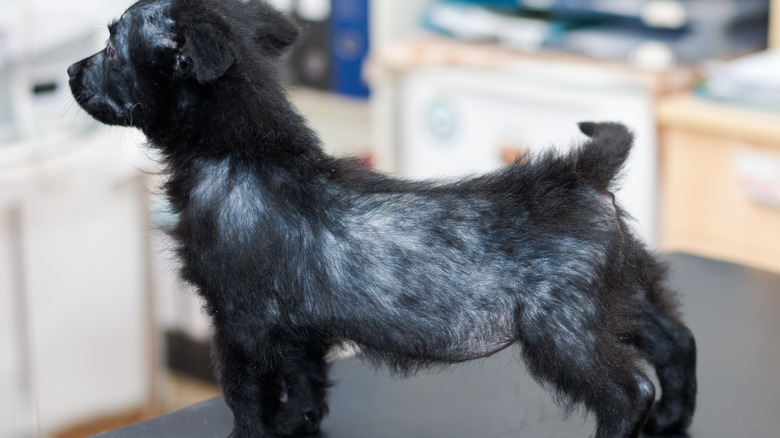Skin Conditions Of Newborn Puppies
It's not uncommon to see a newborn puppy with a skin infection. During the first six months of life, their skin and hair go through big changes, which may cause hereditary skin conditions to present themselves. An undeveloped immune system also makes puppies more susceptible to viral, bacterial, and fungal skin infections. Always talk to your vet before attempting to treat your puppy's skin condition. There are many conditions that have similar symptoms, and what works for one infection might make another one worse.
Newborn puppy skin infection from ringworm
You might be surprised to learn that the condition known as ringworm isn't really a worm. It's a fungal infection that causes an itchy, circular mark on the skin. It can only be picked up through broken skin, and it spreads through contact. Animals without any visible marks can spread the infection through fungal spores in their hair or the last remaining spores after the visible irritation has disappeared.
Since infected animals shed spores everywhere they go, isolate them until they test negative for ringworm and disinfect all other areas of the home. Get other pets tested as well to make sure it hasn't spread. Your vet may treat ringworm with oral medication to prevent the fungus from reproducing and spreading as well as topical medication, which kills the existing spores.
Pyoderma
Pyoderma is an unpleasant condition that causes scaly patches on your puppy's skin along with bald spots. Typically, pyoderma happens as a result of a fungal or bacterial infection, though fleas and ticks can also contribute to it. Although any puppy can develop pyoderma, certain breeds with loose skin, including the Shar-Pei, pug, and bulldog are more likely to develop it.
Most puppies show signs of pyoderma within a few weeks of birth. This is why it's critical to monitor your pup for any signs of discomfort, itching, or pain. The condition usually presents itself on delicate areas like the underarms and near the groin, and may include blisters, pus, and scabs. If you notice any of these in your puppy, seek prompt medical care. They will likely need several weeks of antibiotics and/or medicated shampoos to control the infection. The good news is pyoderma isn't contagious, so if one puppy in a litter has it, there's no worry that it will spread.
Demodectic mange (demodex)
Mange is a skin condition caused by mites. There are two types of mites that cause two different types of mange: demodectic mange and sacrcoptic mange.
Demodectic mange, also known as demodex or red mange, is caused by a mite called Demodex canis. These mites are passed from mother to puppy and normally live within hair follicles. Since a puppy's immune system is underdeveloped, it might be unable to keep the number of mites within a normal range. They can become overpopulated and cause your dog to experience hair loss, redness, scaling, infection, swelling, and crusty patches. Demodex can be localized in patches or generalized, occurring all over the body.
Sarcoptic mange (scabies)
Sarcoptic mange, also known as scabies, is caused by a mite called Sarcoptes scabiei. These mites don't normally live on the skin, and the condition is highly contagious for dogs and humans. These mites burrow under the skin and lay eggs. When they hatch, they eat the skin around them. Scabies causes redness, hair loss, extreme itchiness, thickened skin, and inflammation of the lymph nodes. In extreme cases, it can cause dogs to waste away.
Treatment for both types of mange may include clipping your puppy's hair; giving weekly baths with medicated shampoo; repeated topical treatments using a dip, shampoo, or ointment to kill the mites; and possibly oral medication.
Juvenile cellulitis (puppy strangles)
If you see scabs on newborn puppies, it might be a case of juvenile cellulitis. Juvenile cellulitis, also known as puppy strangles, is one of the less common newborn puppy skin diseases, and it's triggered by an immune response. It's most often seen in puppies between 3 and 16 weeks of age. Golden retrievers, beagles, and Gordon setters are predisposed to the condition, which suggests it may be inherited. It's also one of the most common skin problems in dachshunds.
Puppy strangles presents as a series of symptoms. First, the face and muzzle suddenly swell. Pustules form over the lips, muzzle, and inside ear canals, which eventually burst and scab over. If the condition isn't treated, it can spread from the face to the body.
Other symptoms include swollen lymph nodes in the neck, fever, loss of appetite, and low energy. In some cases, puppies also experience joint pain, which may cause limping. Since juvenile cellulitis is an autoimmune disease, treatment may include an oral steroid, such as prednisone, to suppress the immune system as well as antibiotics to treat infection and inflammation in open wounds.
Other hereditary skin conditions
In some cases, your puppy may show signs of a skin condition that is unrelated to any infection. Follicular dysplasia is one inherited skin condition that causes hair loss and unusual hair growth. It typically shows up within the first few weeks of your puppy's life.
Another condition that may be present at birth is cutaneous asthenia, which causes skin to become loose and stretchy. The risk to this condition is that it can lead to swelling and make your pup highly susceptible to cuts and wounds. You can help your puppy manage this condition by taking extra care to create an environment that minimizes their chance of injury.
Although rare, congenital hypotrichosis may also present in your dog as early as birth.
This causes your dog to experience inconsistent patches of hair growth on their body, face, and eyelashes. In some cases, the affected areas can cause itching and pain, along with shedding.
At the time of writing, there is no treatment for the condition, but certain shampoo and grooming products may manage hair loss and pain.






